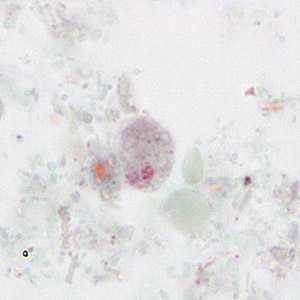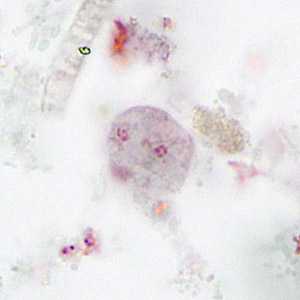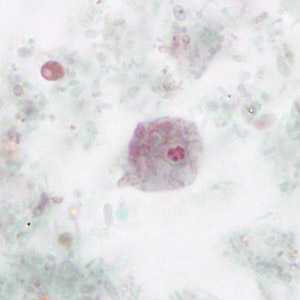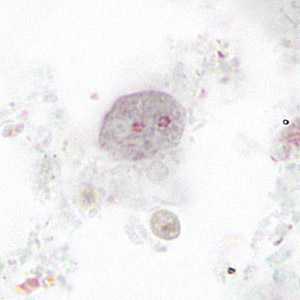
Case #266 - December, 2009
A 29-year-old man went to a local clinic with complaints of intermittent abdominal cramping and mild diarrhea. He explained that he had been diagnosed with roundworms (Ascaris lumbricoides) three months prior and was concerned that he may not have completely cleared the infection. Stool specimens were collected in formalin and polyvinyl alcohol (PVA) for routine ova and parasite (O&P) work-up. Figures A-D show what was observed in moderate numbers on a trichrome-stained smear made from the PVA specimen. The objects ranged in size from 9-12 micrometers. All images were taken at 1000x magnification. What is your diagnosis? Based on what criteria?

Figure A

Figure B

Figure C

Figure D
Case Answer
The organisms identified in this case were trophozoites of Dientamoeba fragilis. Diagnostic features seen in the images included:
- uninucleate and binucleate trophozoites.
- nuclei demonstrating fragmented karyosomes and no peripheral chromatin.
- a size range compatible with that of D. fragilis (5-15 micrometers).
More on: Dientamoeba fragilis
Images presented in the monthly case studies are from specimens submitted for diagnosis or archiving. On rare occasions, clinical histories given may be partly fictitious.
DPDx is an education resource designed for health professionals and laboratory scientists. For an overview including prevention and control visit www.cdc.gov/parasites/.
- Page last reviewed: August 24, 2016
- Page last updated: August 24, 2016
- Content source:
- Global Health – Division of Parasitic Diseases and Malaria
- Notice: Linking to a non-federal site does not constitute an endorsement by HHS, CDC or any of its employees of the sponsors or the information and products presented on the site.
- Maintained By:


 ShareCompartir
ShareCompartir